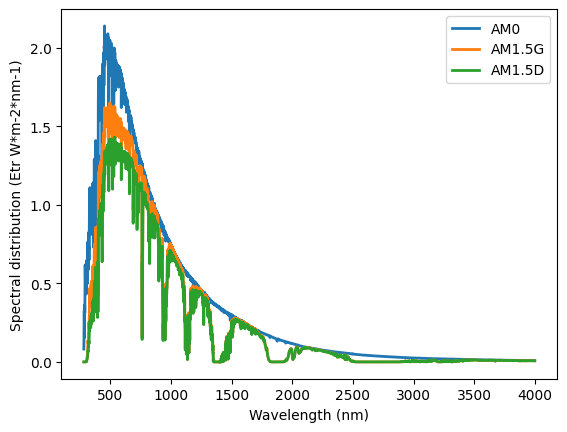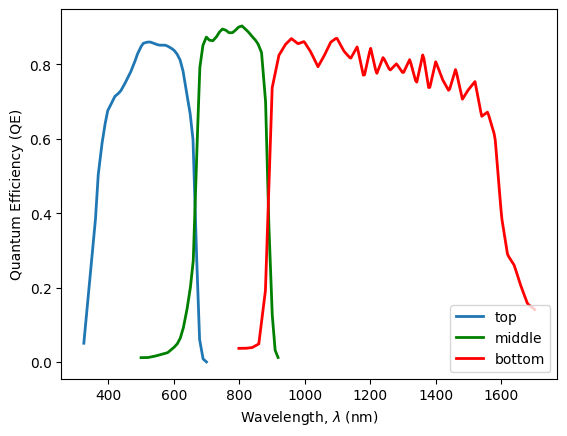Problem 15.6#
Fundamentals of Solar Cells and Photovoltaic Systems Engineering
Solutions Manual - Chapter 15
Problem 15.6
Obtain the short-circuit current density \(J_{SC}\) under the AM0 spectrum for each subcell of the III-V triple junction solar cell used in Problem 6.1, using the tabulated data for the Quantum Efficiency (QE) provided in the online repository of this book. Calculate the current balance of the top and middle subcells (\(J_{SC,top}\)/\(J_{SC,middle}\)) and compare it with the results obtained in Problem 6.1. What changes could be incorporated into the structure of the solar cell to enhance the current balance of the top and middle subcells under the AM0 spectrum?
We will use the package pandas to handle the data and matplotlib.pyplot to plot the results.
import pandas as pd
import numpy as np
import matplotlib.pyplot as plt
We start by importing the data for the solar spectra.
datafile = pd.read_csv('data/Reference_spectrum_ASTM-G173-03.csv', index_col=0, header=0)
datafile
| AM0 | AM1.5G | AM1.5D | |
|---|---|---|---|
| Wvlgth nm | Etr W*m-2*nm-1 | Global tilt W*m-2*nm-1 | Direct+circumsolar W*m-2*nm-1 |
| 280 | 8.20E-02 | 4.73E-23 | 2.54E-26 |
| 280.5 | 9.90E-02 | 1.23E-21 | 1.09E-24 |
| 281 | 1.50E-01 | 5.69E-21 | 6.13E-24 |
| 281.5 | 2.12E-01 | 1.57E-19 | 2.75E-22 |
| ... | ... | ... | ... |
| 3980 | 8.84E-03 | 7.39E-03 | 7.40E-03 |
| 3985 | 8.80E-03 | 7.43E-03 | 7.45E-03 |
| 3990 | 8.78E-03 | 7.37E-03 | 7.39E-03 |
| 3995 | 8.70E-03 | 7.21E-03 | 7.23E-03 |
| 4000 | 8.68E-03 | 7.10E-03 | 7.12E-03 |
2003 rows × 3 columns
datafile.drop(datafile.index[0], inplace=True) #remove row including information on units
datafile=datafile.astype(float) #convert values to float for easy operation
datafile.index=datafile.index.astype(float) #convert indexes to float for easy operation
We can also plot the three spectra
plt.plot(datafile,
linewidth=2, label=datafile.columns)
plt.ylabel('Spectral distribution (Etr W*m-2*nm-1)')
plt.xlabel('Wavelength (nm)')
plt.legend()
<matplotlib.legend.Legend at 0x7f24a0f68150>

We define the relevant constants and import the QE of the triple junction solar cell.
h=6.63*10**(-34) # [J·s] Planck constant
e=1.60*10**(-19) # [C] electron charge
c =299792458 #[m/s] Light speed
QE_data = pd.read_csv('data/QE_triple_junction_solar_cell.csv', index_col=0, header=0)
QE_top=QE_data['QE top'].dropna()
QE_data.set_index('nm middle', inplace=True)
QE_mid=QE_data['QE middle'].dropna()
QE_data.set_index('nm bottom', inplace=True)
QE_bot=QE_data['QE bottom'].dropna()
QE_top?
We can plot the Quantum Efficiency.
plt.plot(QE_top, linewidth=2, label='top', )
plt.plot(QE_mid, linewidth=2, label='middle',color='green')
plt.plot(QE_bot, linewidth=2, label='bottom', color='red')
plt.ylabel('Quantum Efficiency (QE)')
plt.xlabel('Wavelength, $\lambda$ (nm)');
plt.legend(loc='lower right')
<matplotlib.legend.Legend at 0x7f24a0d5df90>

For the top subcell, we calculate the spectral response, interpolate the spectrum, and integrate to obtain the short-circuit current density using Eq. 3.5.
\(J=\int SR(\lambda) \cdot G(\lambda) \ d\lambda\)
In this case, we assume the extraterrestrial irradiance AM0.
QE=QE_top
SR=pd.Series(index=QE.index,
data=[QE.loc[i]*e*i*0.000000001/(h*c) for i in QE.index])
spectrum='AM0'
spectra=datafile[spectrum]
spectra_interpolated=np.interp(SR.index, spectra.index, spectra.values)
J_top = np.trapz([x*y for x,y in zip(SR, spectra_interpolated)], x=SR.index)*1000/10000 # A-> mA ; m2 -> cm2
print('Photocurrent density top = ' + str(J_top.round(1)) + ' mA/cm2')
Photocurrent density top = 17.4 mA/cm2
/tmp/ipykernel_3692/431403739.py:9: DeprecationWarning: `trapz` is deprecated. Use `trapezoid` instead, or one of the numerical integration functions in `scipy.integrate`.
J_top = np.trapz([x*y for x,y in zip(SR, spectra_interpolated)], x=SR.index)*1000/10000 # A-> mA ; m2 -> cm2
We repeat the analysis for the middle subcell.
QE=QE_mid
SR=pd.Series(index=QE.index,
data=[QE.loc[i]*e*i*0.000000001/(h*c) for i in QE.index])
spectra=datafile[spectrum]
spectra_interpolated=np.interp(SR.index, spectra.index, spectra.values)
J_mid = np.trapz([x*y for x,y in zip(SR, spectra_interpolated)], x=SR.index)*1000/10000 # A-> mA ; m2 -> cm2
print('Photocurrent density middle = ' + str(J_mid.round(1)) + ' mA/cm2')
Photocurrent density middle = 15.2 mA/cm2
/tmp/ipykernel_3692/1830044442.py:8: DeprecationWarning: `trapz` is deprecated. Use `trapezoid` instead, or one of the numerical integration functions in `scipy.integrate`.
J_mid = np.trapz([x*y for x,y in zip(SR, spectra_interpolated)], x=SR.index)*1000/10000 # A-> mA ; m2 -> cm2
We repeat the analysis for the bottom subcell.
QE=QE_bot
SR=pd.Series(index=QE.index,
data=[QE.loc[i]*e*i*0.000000001/(h*c) for i in QE.index])
spectra=datafile[spectrum]
spectra_interpolated=np.interp(SR.index, spectra.index, spectra.values)
J_bot = np.trapz([x*y for x,y in zip(SR, spectra_interpolated)], x=SR.index)*1000/10000 # A-> mA ; m2 -> cm2
print('Photocurrent density bottom = ' + str(J_bot.round(1)) + ' mA/cm2')
Photocurrent density bottom = 27.6 mA/cm2
/tmp/ipykernel_3692/1590478743.py:8: DeprecationWarning: `trapz` is deprecated. Use `trapezoid` instead, or one of the numerical integration functions in `scipy.integrate`.
J_bot = np.trapz([x*y for x,y in zip(SR, spectra_interpolated)], x=SR.index)*1000/10000 # A-> mA ; m2 -> cm2
The middle subcell determines the current flowing throughout the device since it is the subcell that generates the lowest current. The current balance of the top and middle subcells (\(J_{SC,top}\)/\(J_{SC,middle}\)) can be calculated as follows:
J_top/J_mid
np.float64(1.1427435817154772)
In this case, the top subcell is producing 14 % more current than the middle subcell. This can be compared with the performance under AM1.5G spectrum when the top subcell only produces 1% extra relative to the middle subcell.
What changes could be incorporated in the structure of the solar cell to enhance the current balance of the top and middle subcells under the AM0 spectrum?
In order to improve the current balance, the thickness of the top subcell should be reduced. Alternatively, a higher bandgap material could be used in the top subcell which would reduce its current and increase that of the middle subcell, improving the balance under AM0.

